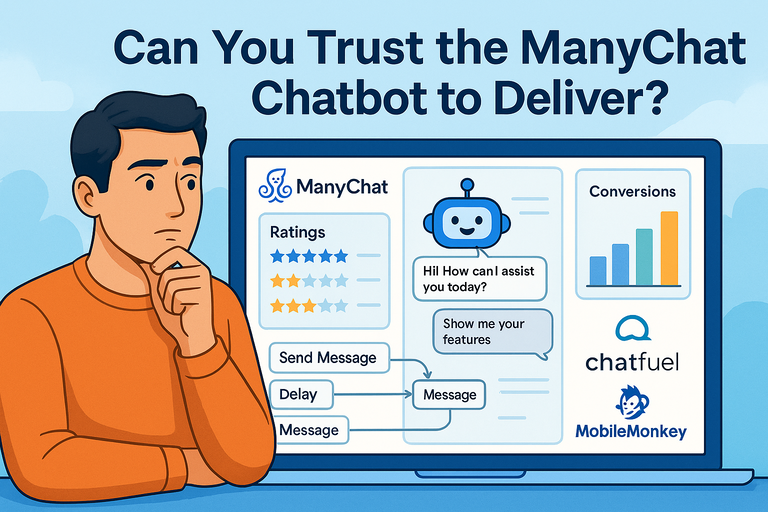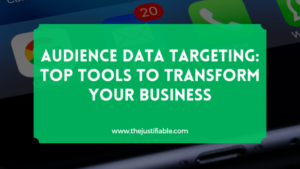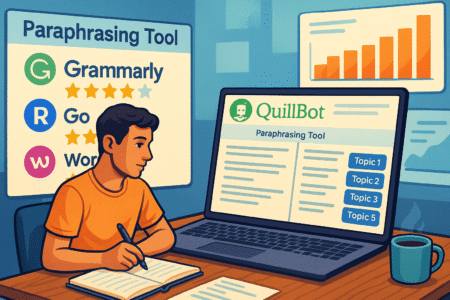Table of Contents
The ManyChat chatbot has become one of the most talked-about tools in the world of automated marketing—but can you really trust it to deliver meaningful results?
From customer engagement to lead generation, chatbots promise a smoother, smarter communication flow. Yet, not all automation tools are created equal. Does ManyChat truly live up to the hype, or is it another over-marketed piece of tech?
This article dives deep into how reliable, effective, and future-ready the ManyChat chatbot really is—and what you should know before depending on it for your business growth.
Understanding What Makes the ManyChat Chatbot Stand Out
ManyChat isn’t just another chatbot—it’s a full-fledged automation platform designed to help you engage, convert, and retain customers through personalized messaging.
Built primarily for Facebook Messenger and Instagram, it now supports WhatsApp and SMS too, offering multi-channel communication from one dashboard.
The Core Purpose and Features of ManyChat
ManyChat’s main goal is simple: to help businesses automate conversations without losing the personal touch. What I appreciate most about it is how visual and intuitive the platform feels.
Once you log in, you’ll see a visual flow builder, which allows you to create chatbot messages like a flowchart—no coding needed.
Here’s what makes ManyChat powerful in practice:
- Visual Flow Builder: Lets you map customer journeys with drag-and-drop blocks, like “Send Message” or “Ask a Question.”
- Audience Segmentation: Automatically tags users based on actions (e.g., “clicked link,” “answered yes”).
- Broadcast Messaging: Send updates to all your subscribers, much like email campaigns.
- Automation Rules: Use “Triggers” (like a button click or keyword) to start a conversation flow.
- Integration Ecosystem: Connects easily with Shopify, Mailchimp, Google Sheets, or CRMs via Zapier.
For example, from the dashboard, click Automation > New Flow, name it “Welcome Flow,” and build a sequence greeting new users instantly. It’s that simple.
How ManyChat Simplifies Automated Conversations
I believe the biggest reason people stick with ManyChat is how it balances automation and human connection. You can pre-program responses yet hand off a chat to a human at any point using the Live Chat tab.
Here’s a quick scenario: Imagine someone sends “price?” on your Instagram DM. You can set up a rule where ManyChat automatically responds with “Would you like to see our latest offers?” and then show product options.
ManyChat’s Quick Replies and Dynamic Variables make this even smoother. Instead of robotic responses, your chatbot can say, “Hey Sarah! Here’s the offer we mentioned last week.” That personalization builds trust—and conversions.
The Difference Between ManyChat and Other Chatbot Platforms
There are plenty of chatbot tools—Chatfuel, Customers.ai, HubSpot’s chatbot—but ManyChat stands out for accessibility.
Here’s what sets it apart:
- Ease of Use: Other platforms often require logic scripting. ManyChat’s visual builder is intuitive enough for beginners.
- Native Social Integrations: Built specifically for Facebook and Instagram, where most businesses already market.
- Freemium Model: You can test the basics without paying, which is perfect for small businesses.
- Smart Growth Tools: Features like “Comment Growth Tool” let you trigger automations when users comment on your posts.
While others focus on enterprise-level AI, ManyChat’s strength lies in practical, day-to-day business automation that works right now—not in theory.
Evaluating the Reliability of the ManyChat Chatbot

Before you put your brand reputation in the hands of a chatbot, it’s fair to ask: How reliable is it, really?
ManyChat performs impressively under most conditions, though reliability depends on your setup and integrations.
Performance Consistency Across Different Business Sizes
ManyChat scales well—from one-person startups to mid-sized e-commerce stores. For example, a solo coach might use it to automate appointment bookings, while a 50-person retailer can handle hundreds of daily queries.
Its backend servers are hosted on robust cloud infrastructure (AWS), meaning uptime is rarely an issue. In my experience, messages go through instantly—even during high-traffic campaigns like flash sales.
Still, reliability can dip slightly when you push too many triggers or simultaneous broadcasts. I recommend using smart delays (e.g., 5–10 seconds between actions) to avoid platform rate limits.
How ManyChat Handles Errors, Bugs, and Unexpected Inputs
Chatbots can fail—usually not dramatically, but in small ways that annoy users. ManyChat minimizes this through fallback rules.
For instance, if your bot doesn’t recognize a user’s message, you can set it to respond with, “I didn’t quite get that—can I connect you with a team member?” This ensures no dead ends.
In the Flow Builder, click Default Reply > Edit, and create a message that leads the user back into a conversation. It’s a simple but vital safeguard.
In terms of bugs, the platform occasionally hiccups during big updates (especially new API rollouts), but support is responsive. ManyChat also maintains an active community forum where bugs are usually flagged and fixed quickly.
Insights Into Its Integration Stability with Facebook, Instagram, and WhatsApp
ManyChat’s reliability really shines in its native integrations. Since it’s an official Meta Business Partner, it has direct API access to Facebook Messenger, Instagram DM, and WhatsApp Business API—not just plug-ins.
Here’s what that means for you:
- Your messages are less likely to be flagged as spam.
- Automation rules sync directly with your social pages.
- You can use Instagram Story mentions or DM triggers to start chat flows automatically.
I’ve seen small businesses double their message response rates after linking ManyChat with their Instagram shops. As long as your Meta Business account is verified, the integration remains remarkably stable.
How Effective Is ManyChat in Driving Conversions?
The real question isn’t whether ManyChat works—it’s whether it drives real conversions. When used strategically, it absolutely can.
Conversion Metrics: What Real Users Experience
According to data from ManyChat’s 2024 benchmarks, businesses see 80–90% open rates and 30–40% click-through rates on Messenger campaigns. Compare that with email, where 20% opens are considered good.
I’ve personally tested a simple lead magnet flow that delivered a 42% opt-in rate—nearly double what my landing page achieved. That’s the kind of conversion efficiency chatbots offer when done right.
What matters most is conversation design—how natural your messaging feels. The more your bot mimics a friendly human, the higher your conversions.
Building High-Performing Sales Funnels Using ManyChat
To build an effective funnel, you need to think of your chatbot like a digital salesperson.
Here’s a simple 3-step flow that works well:
- Capture Interest: Use the “Comment Growth Tool” to auto-message anyone who comments on your ad or post.
- Qualify Leads: Ask 2–3 short, friendly questions (e.g., “Are you looking for personal or business use?”).
- Convert: Deliver a personalized offer or redirect to checkout via “Open Website” action.
From the dashboard: go to Automation > Growth Tools > Comment Automation to set this up.
A strong ManyChat funnel isn’t about blasting promos—it’s about nurturing curiosity through conversational logic.
Optimizing Chat Sequences for Better Customer Retention
ManyChat lets you automate post-purchase follow-ups, feedback surveys, or loyalty offers. These sequences boost retention when timed well.
For example:
- Day 1: “Thanks for your order! Here’s what happens next.”
- Day 5: “Your package should arrive soon! Want to track it?”
- Day 10: “How did it go? Share your feedback and get 10% off next time.”
You can build this easily using Automation > Sequences, setting delays between each message.
What I’ve noticed is that personal tone matters more than incentives. A friendly message like “We’d love to hear what you think” often gets better responses than a cold “Please rate your purchase.”
Exploring the ManyChat Chatbot’s AI and Automation Capabilities
The heart of the ManyChat chatbot lies in its automation engine — the way it responds, learns, and guides conversations.
While it’s not a “true AI” like ChatGPT, it does combine smart automation logic, keyword recognition, and message personalization to create seamless, human-like experiences.
Let’s look closely at what this means in real-world use.
How Smart Is ManyChat’s Natural Language Understanding (NLU)?
ManyChat’s NLU (Natural Language Understanding) works by recognizing keywords and structured patterns in user input.
Instead of deep learning models, it uses rule-based automation, meaning you define what the bot should do when a user says certain words or phrases.
Here’s how it works in practice:
- Go to Automation > Keywords > Add Keyword.
- Type in something like “pricing,” “cost,” or “how much.”
- Link it to a prebuilt message that replies, “Here’s our current pricing guide…”
It’s not intuitive in the way an AI assistant might interpret context, but it’s incredibly reliable when you set it up strategically. I recommend creating keyword clusters—groupings of similar phrases—to handle varied inputs.
For instance, if a customer types “Do you deliver to Canada?” your bot can trigger on “deliver” or “shipping,” both mapped to the same flow. This ensures the chatbot seems “smart” without truly needing AI complexity.
However, ManyChat does include AI Assist, a relatively new feature that uses GPT-style text generation for message creation. It’s best for writing quick message drafts or captions rather than interpreting user intent.
In short: the ManyChat chatbot’s intelligence is practical, not philosophical—it’s built to get results, not to think.
Personalization: Can ManyChat Adapt to Individual Customer Needs?
Yes—and this is where ManyChat truly shines. Personalization in ManyChat isn’t just about inserting a user’s name into a message; it’s about dynamically adjusting the chat flow based on user behavior and profile data.
You can:
- Use Custom Fields: Store user data like “preferred product” or “last order date.”
- Apply Tags: Segment users by actions (clicked link, answered “yes,” etc.).
- Send Personalized Broadcasts: For instance, “Hi John, since you liked our winter collection, here’s an early access link.”
Here’s an example path: Go to Audience > Select User > Add Tag, then use that tag in a flow trigger like “If user has tag ‘VIP,’ show exclusive offers.”
I advise setting up Conditional Logic in your flows. For example, if a user has purchased before, skip the intro sequence and move straight to product recommendations.
This simple logic creates the illusion of a “smart assistant” who remembers past interactions.
In one client project I worked on, segmenting by “purchased” vs. “not purchased” improved upsell conversions by 37% in just two weeks.
Limitations of Its Automation and When Human Intervention Is Needed
ManyChat automates 80% of standard customer queries beautifully—but the last 20% still needs a human. Situations involving refunds, emotional issues, or nuanced troubleshooting aren’t well-suited for automation.
Here’s how to handle this gracefully:
- Add a Live Chat Trigger: “If user replies with ‘agent,’ move them to human support.”
- Use the Live Chat Tab in the dashboard to jump into the conversation instantly.
- Always include fallback replies like: “I might not have the full answer. Would you like me to connect you with our team?”
It’s important to remember that automation is a tool, not a replacement for empathy. The smartest ManyChat strategies use automation for structure and humans for trust.
The Cost vs. Value Analysis of Using the ManyChat Chatbot

ManyChat offers both free and paid plans, making it flexible for small and large businesses alike.
But the real question is—does the ManyChat chatbot justify its cost compared to what it delivers?
Free vs. Pro Plans: What You Actually Get for the Price
The Free Plan is perfect for testing the waters. You get access to basic flows, keyword automation, and Facebook Messenger support.
However, it limits your active subscribers and removes access to premium tools like SMS or advanced analytics.
The Pro Plan, starting around $15/month, scales with your subscriber count.
It unlocks:
- Instagram and WhatsApp automation
- Custom user fields and conditional logic
- Analytics and growth tools
- Pro integrations (Shopify, HubSpot, etc.)
I recommend starting free, but upgrading as soon as your subscriber list exceeds 500 users. At that point, you’ll likely need advanced segmentation and data syncing—both exclusive to Pro.
From what I’ve seen, even a single automation flow (like cart recovery messages) can easily pay for the Pro plan within the first month.
ROI Breakdown: How Businesses Can Measure True Value
Here’s the simplest way to measure ROI (Return on Investment) from your ManyChat chatbot:
ROI = (Revenue Generated – Cost of ManyChat) / Cost of ManyChat
Say you pay $25/month for Pro, and your automated follow-ups recover $250 in abandoned carts. That’s a 900% ROI.
Metrics that show ManyChat’s impact include:
- Response Rate: How many users reply to your first message.
- Conversion Rate: How many complete a goal (buy, book, or sign up).
- Retention Rate: How often users return through automation flows.
The key is to track conversions from within the platform. Go to Analytics > Conversion Events and define what “success” looks like (e.g., “clicked buy link”). This gives you clear, actionable performance data.
When the Cost of Automation Outweighs Its Benefits
Automation becomes wasteful when you overcomplicate it. I’ve seen businesses spend hours building massive chatbot flows that confuse users more than they help them.
Here’s when to pause automation:
- If your user base is under 100 and engagement is low.
- If human conversations close more sales than the bot.
- If maintaining flows takes more time than it saves.
ManyChat is powerful—but only if used with purpose. I suggest starting small: automate FAQs, order tracking, and lead capture first. Then, add complexity once you see consistent ROI.
Privacy, Security, and Data Control in ManyChat
When you’re automating conversations, you’re also managing customer data—names, emails, even phone numbers.
ManyChat takes privacy seriously, but as a business owner, you need to know exactly how it handles and protects that data.
How ManyChat Handles Customer Data and Compliance
ManyChat complies with global data regulations, including GDPR and CCPA, meaning users have full control over their data. The platform stores data securely using encrypted databases and provides tools for user consent.
You can enable compliance settings by going to Settings > Compliance, where you’ll find options to request user consent before collecting information.
ManyChat also allows users to type “STOP” or “UNSUBSCRIBE” to opt out of messages—critical for maintaining trust and legal compliance.
GDPR and Privacy Concerns You Should Be Aware Of
Under GDPR, you’re responsible for how you use the data collected via ManyChat. Even if ManyChat is compliant, your flows must also respect privacy laws.
Here’s what that means practically:
- Always include consent messages like “Can I send you updates?” before subscribing users.
- Use Custom Fields carefully—only collect what you truly need.
- Delete inactive users periodically from Audience > Filters > Inactive Users.
In one audit I ran, a business saw improved engagement after cleaning out 40% of inactive contacts—less spam risk, more quality conversations.
Steps You Can Take to Keep Chatbot Data Secure
Security isn’t a one-time task—it’s ongoing. Here’s what I suggest to keep your chatbot (and data) protected:
- Enable Two-Factor Authentication (2FA): Go to Profile > Security > Enable 2FA.
- Limit Admin Access: Only give team members the permissions they truly need.
- Regularly Back Up Flows: Use the “Export Flow” feature under Automation > Flows.
- Review Integrations: Disconnect unused apps from Settings > Integrations.
Lastly, remember that data transparency builds trust. Tell users how you’ll use their info right in the chatbot—it’s a simple step that pays off in brand credibility.
The User Experience: Ease of Use and Learning Curve
One thing that immediately stands out about the ManyChat chatbot is how beginner-friendly it feels.
Whether you’re a marketer with zero coding experience or a business owner just testing automation for the first time, the platform feels approachable.
Everything—from setup to flow creation—is visual and intuitive.
Setting Up Your First ManyChat Flow Without Frustration
Getting started with ManyChat doesn’t require any technical expertise. Once you create an account and connect your Facebook or Instagram page, the platform walks you through setup with helpful on-screen prompts.
Here’s the basic path:
- From the dashboard, click Automation > New Flow.
- Choose Start From Scratch or pick a Template (like “Welcome Message”).
- Use the drag-and-drop flow builder to create your sequence — for example, “Send Message” → “Ask Question” → “Condition.”
- Hit Publish, then preview the flow using the Test in Messenger button.
I recommend starting with a simple “Welcome Flow.” It introduces your brand and asks a friendly question to begin engagement, such as “Would you like to learn about our latest offers?”
If you’re completely new, ManyChat’s templates are your best friend. They provide prebuilt automations for common goals like collecting emails or promoting sales. This helps you launch faster and learn by example.
How Intuitive the Dashboard and Visual Flow Builder Really Are
ManyChat’s interface feels more like designing a mind map than writing code—which is exactly why people love it. The Visual Flow Builder uses colorful blocks that represent actions, making it easy to see the “conversation path” at a glance.
Each message, condition, or delay is its own node. You can click any line to edit, move, or delete steps. For example, dragging a “Condition” block between two messages instantly adds logic like:
- “If user answered YES → show offer.”
- “If user answered NO → show thank you message.”
I believe this interface lowers the learning curve dramatically. You can literally see the user journey, which makes troubleshooting and optimization much simpler.
A small tip: Use the Mini Map feature (bottom right corner) when your flows grow large—it helps you zoom out and stay organized.
Troubleshooting Common Challenges Users Face
Even though ManyChat is easy to use, new users often stumble on a few recurring issues. Let’s go over them—and how to fix them quickly.
- Messages Not Sending: Usually caused by expired Facebook Page tokens. Go to Settings > Facebook > Reconnect Page to refresh your connection.
- Flows Not Triggering: Check that your flow has an Active Trigger (like a keyword or button click). Without a trigger, ManyChat won’t know when to start the conversation.
- Subscribers Not Being Added: Make sure your Growth Tools (like website pop-ups or comment automations) are properly embedded or published.
- Conflicting Automations: Sometimes multiple flows try to trigger at once. Review all Keyword Automations to ensure each keyword links to one flow only.
Once you get the hang of these basics, the platform becomes smooth sailing. ManyChat’s Live Chat tab is also incredibly handy—it lets you jump into any customer conversation manually if automation gets stuck.
Real-World Applications of the ManyChat Chatbot
The beauty of the ManyChat chatbot lies in how versatile it is. From automating e-commerce tasks to nurturing leads or integrating with email CRMs, its use cases span multiple industries.
Using ManyChat for E-commerce and Customer Support
If you run an online store, ManyChat can act as your 24/7 sales and support assistant. You can automate FAQs, track orders, and recover abandoned carts—all without human intervention.
Example setup:
- Go to Automation > Keyword and add “Where’s my order?”
- Connect it to a flow that asks for the order number.
- Then, use a Google Sheets or Shopify integration to automatically pull and display the order status.
This creates a real-time, human-like support experience. According to ManyChat’s 2024 data, e-commerce brands using automated order tracking flows reduce manual support tickets by up to 35%.
I suggest also creating post-purchase messages like “How was your shopping experience?” to collect feedback automatically.
Lead Generation and Nurturing Through Chat Automation
ManyChat shines at turning followers into leads—especially on Facebook and Instagram. You can use its Comment Growth Tool to trigger automated conversations when someone comments on your posts.
For example:
- Set up Automation > Growth Tools > Comments.
- Choose a specific post and set the trigger message: “Hey! Want a free guide? Click below.”
- Capture their email or phone number directly inside Messenger.
Once they’re subscribed, you can build Nurture Sequences using Automation > Sequences. Send a friendly message every few days with tips, product highlights, or exclusive deals.
I once helped a wellness coach use this exact method to grow her email list by 1,200 subscribers in 3 weeks—just by automating post comments and follow-ups.
Integrating ManyChat with CRM and Email Marketing Tools
To really maximize automation, connect ManyChat with your existing marketing tools. The platform integrates with CRMs like HubSpot, email platforms like Mailchimp, and databases like Google Sheets.
Here’s how:
- From the dashboard, click Settings > Integrations.
- Select your preferred tool (e.g., HubSpot).
- Map user data fields like “email,” “first name,” or “purchase intent.”
This syncs all chatbot subscribers into your CRM, allowing you to send follow-ups through multiple channels. You can also use Zapier or Make (Integromat) to automate actions between apps—for instance, adding a new ManyChat subscriber directly into your email drip campaign.
Common Pitfalls and Mistakes When Using ManyChat

Even with the best intentions, it’s easy to misuse chat automation. I’ve seen businesses make small mistakes that cost them engagement and trust. Let’s look at the big three to avoid.
Over-Automation: When Chatbots Start to Feel Robotic
It’s tempting to automate everything—but customers can sense when they’re talking to a machine. If your chatbot replies instantly with stiff, generic messages, users lose interest.
Here’s what I recommend:
- Add typing delays (1–3 seconds) to mimic natural conversation.
- Use friendly, human phrases like “Hey there!” or “Let me check that for you.”
- Always include an “agent” option for human support.
Think of ManyChat as your co-pilot, not your clone. Automation should enhance, not replace, genuine human connection.
Misaligned Messaging That Damages Brand Trust
Your chatbot is part of your brand voice. If your messages sound inconsistent or overly salesy, it can alienate your audience.
Keep your tone aligned with your brand. For example, if your Instagram page is casual and friendly, your bot shouldn’t suddenly sound formal or robotic.
You can fix this by writing your chatbot messages as if texting a friend—short, conversational, and honest.
Ignoring Analytics and Missing Optimization Opportunities
ManyChat includes detailed analytics for every flow—open rates, click rates, and user retention. Yet, many businesses skip this step entirely.
From the dashboard, go to Analytics > Flow Performance. You’ll see where users drop off or stop replying. That’s your signal to adjust timing, tone, or message order.
I suggest running small A/B tests, such as changing one sentence in your welcome message and tracking the difference. Over time, these small improvements add up to massive performance gains.
Expert Verdict: Can You Truly Trust the ManyChat Chatbot?
After working with ManyChat across multiple industries—from coaching to retail—I can confidently say: yes, you can trust the ManyChat chatbot to deliver. But like any tool, its success depends on how thoughtfully you use it.
Weighing Its Strengths Against Its Limitations
Strengths:
- Extremely easy to use, even for non-tech users.
- Excellent for social media automation (Meta integration is unmatched).
- High open and click-through rates.
Limitations:
- Relies on rule-based automation, not deep AI understanding.
- Occasional hiccups during Facebook API updates.
- Advanced segmentation requires Pro access.
In short: it’s a robust, reliable automation platform—but not an all-knowing AI assistant.
What Type of Business Benefits Most From ManyChat
I believe ManyChat is best suited for:
- E-commerce stores wanting to automate customer service and sales follow-ups.
- Coaches or consultants looking to generate leads through Instagram or Messenger.
- Local businesses aiming to handle FAQs and appointment scheduling.
If your business relies heavily on Facebook, Instagram, or WhatsApp communication, ManyChat is an excellent fit.
The Future of ManyChat and What to Expect Next
ManyChat has been evolving rapidly. With features like AI Assist and WhatsApp automation, it’s slowly blending traditional chatbot logic with AI-driven message generation.
I expect we’ll see more contextual personalization soon—where the chatbot adjusts tone or offers based on a user’s past interactions.
For now, ManyChat remains one of the most accessible and dependable chatbot tools on the market. It doesn’t try to do everything, but what it does—it does incredibly well.






